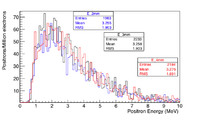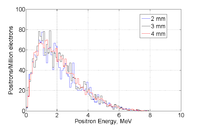Difference between revisions of "G4Beamline PbBi"
Jump to navigation
Jump to search
| Line 20: | Line 20: | ||
The Random number seed is set by Time in G4beamline to use a different set of pseudo random numbers each time it is run | The Random number seed is set by Time in G4beamline to use a different set of pseudo random numbers each time it is run | ||
| + | |||
| + | |||
| + | |||
{| border="1" | {| border="1" | ||
| Line 32: | Line 35: | ||
| 2.5 || 1997 || | | 2.5 || 1997 || | ||
|- | |- | ||
| − | | 3|| 2233 || 1986 | + | | 3|| 2233,2250 || 1986 |
|- | |- | ||
| 3.5|| 2193 || | | 3.5|| 2193 || | ||
Revision as of 21:41, 28 April 2015
Development of a Positron source using a PbBi converter and a Solenoid
Converter target properties
Definition of Lead Bismuth
1cm diameter target
2 mm thick PbBi
0.5 Tesla solenoid
G4BeamLine and MCNPX
Target thickness optimization
First simple test is to send 1 million, 10 MeV electrons towards a PbBi target and count how many positrons leave the downstream side
The Random number seed is set by Time in G4beamline to use a different set of pseudo random numbers each time it is run
| PbBi Thickness (mm) | #positrons/million electrons (G4Beamline) | #positrons/million electrons (MCNPX) |
| 1 | 960 | 1091 |
| 1.5 | 1508 | |
| 2 | 1963,1919,1880,1877,1970 | 1984 |
| 2.5 | 1997 | |
| 3 | 2233,2250 | 1986 |
| 3.5 | 2193 | |
| 4 | 2184 | 1858 |
| 5 | 2042 | 1646 |
| 6 | 1851 | 1541 |
| 10 | 1480 | 1216 |

